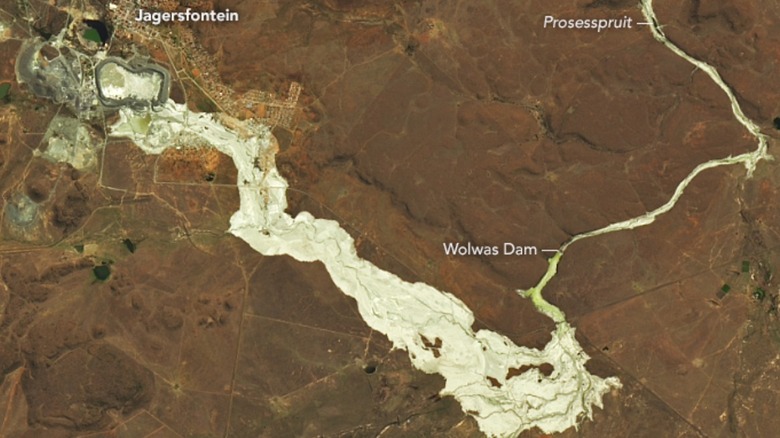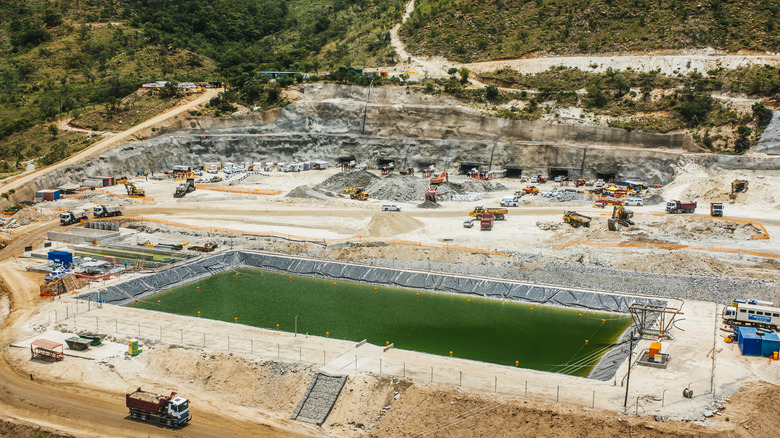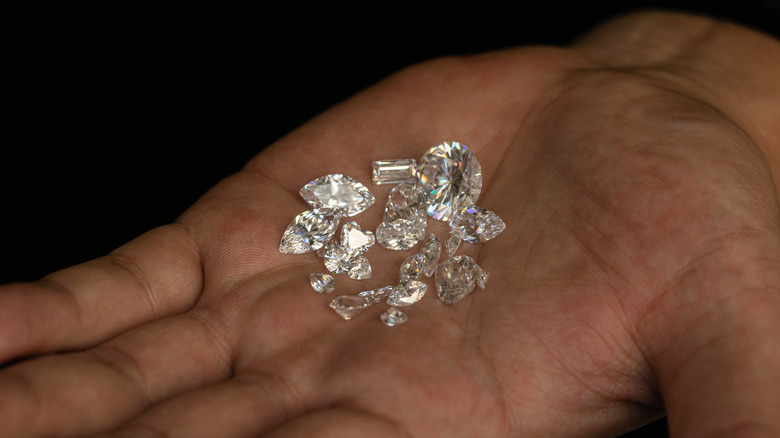What Is Causing South Africa's Poisonous River Of Gold?
On October, 20, 2022, NASA shared a striking satellite image: what appeared to be a golden river gleaming up from a brown and barren landscape. It looked almost like a massive art installation, as if someone had carefully laid gold leaf in a river-like pattern over the Earth. But the truth behind the image was not so pretty. The glimmering substance was actually toxic waste from a deadly tailings dam collapse at a dormant South African diamond mine once owned by De Beers, according to Reuters.
The dam collapsed on September 11 of 2022 in Jagersfontein, South Africa. At around 2 a.m., a truck driver had seen a crack in the dam and alerted a foreman, but no action was taken, The New York Times reported. "He said, 'I'll tell you, that thing is going to blast,'" site pan operator Joe Makalajane recalled. Around four hours later, he was proven right when a torrent of mine waste poured through the collapsed barrier and injured at least 40 people, according to Reuters.
Ultimately, three people died in the toxic flood (via Live Science). Hundreds of animals perished as well, and the deluge destroyed more than 160 homes, according to NASA. One woman who lived near the dam, Rio-Rita Breytenbach, told The New York Times that the flood of waste lifted her off of a chair she was standing on and out of the house. "I was praying that I would survive," she said.
Lasting effects
The fact that the NASA image was taken nearly a month after the initial disaster shows that the impact of the dam collapse lingered beyond the initial flood. The dam was holding back tailings, the word for what's left over after an area is mined for whatever is sought — in this case, diamonds. Tailings are usually a mix of water; crushed rock; trace amounts of metals including copper, mercury, cadmium, and zinc; and additives used in the mining process, such as sulfuric acid and cyanide, according to Earthworks. These tailings are often stored as a wet mixture behind dams made of compacted earth. Because tailings can contain toxic metals, they harm ecosystems if they end up in waterways.
The tailings that spilled out of the Jagersfontein mine stretched approximately 5.3 miles southeast and around a mile wide, according to University of Hull geologist Dave Petley. The pollution damaged more than 10 square miles of grazing land, entered waterways like the Prosesspruit River, and contaminated water systems used for drinking water and agriculture, according to NASA. "Once again, a major tailings failure has caused loss of life and severe environmental damage," Petley wrote. NASA said the brightest spots of the satellite image probably didn't show liquid, but rather dried waste and mud left behind as the water evaporated. As the spill dries further, wind and rain will begin to disperse the remaining deposits.
Warning signs
"This event, in a facility in which mining has ceased, will further raise questions about the long term stewardship of these facilities," Dave Petley wrote of the Jagersfontein dam collapse. Indeed, there has been growing concern about the stability of tailings dams in recent years after a 2019 collapse in Brazil killed more than 250 people, according to The New York Times. The number of failures has increased in recent years, with half of all collapses in the past 70 years taking place between 1990 and 2009, according to Earthworks. Tailings dams are less stable than water dams because they are the result of waste, not the end goal that will earn its constructors money by generating electricity. Because of this, the dams are built up over time and the mining companies cut costs in the construction process.
In the case of the Jagersfontein dam, the instability was increased when the dam's new owners began to sort through the tailings for diamonds that might have been lost in the rough of the initial mining, according to The New York Times. De Beers sold the mine and tailings to a consortium in 2010, and eventually it was controlled by Stargems, a Dubai-based diamond company. The waste grew higher as it was searched, and workers reported leaks. In 2021, the mine was shut briefly when it was revealed that the operators had been storing more than two-and-a-half times the safe amount of waste behind the dam. "It was definitely avoidable," Federation for a Sustainable Environment CEO Mariette Liefferink said of the collapse.
A toxic legacy
The Jagersfontein dam collapse is just one example of the toxic legacy left behind by mining in South Africa. All told, there are hundreds of tailings dams in the country, according to The New York Times. Mining in South Africa was intrinsically linked to colonialism. The Jagersfontein mine, which is one of the oldest diamond mines in the world, saw its first precious stones removed by European settlers in 1870. The jubilee diamond — named in honor of Britain's Queen Victoria — was cut from a 650-carat rock extracted from the mine. But the wealth was not shared with the Black South Africans who largely did the actual mining or the communities left to deal with the waste.
Diamond mines aren't the only source of legacy pollution in South Africa. The Witwatersrand goldfields, for example, left behind both tailings dams and acid mine drainage, according to Earth. "Over 120 years, in more than 120 mines, companies simply mined, they did not address the long-term environmental impacts, especially the impacts on water," Mariette Liefferink said. "They maximized their profits and externalized the costs."



